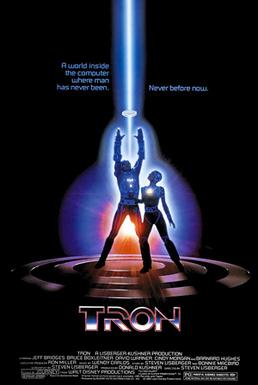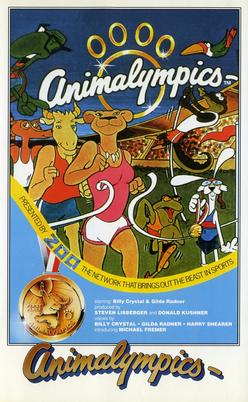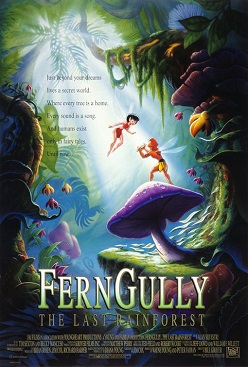
Computer animation is the process used for digitally generating animations. The more general term computer-generated imagery (CGI) encompasses both static scenes and dynamic images, while computer animation only refers to moving images. Modern computer animation usually uses 3D computer graphics. The animation's target is sometimes the computer itself, while other times it is film.
Modern animation in the United States from 1987 to 2004 is widely referred to as the silver age of American animation. During this period, many large American entertainment companies reformed and reinvigorated their animation departments, following a dark age during the late 1950s to mid-1980s. During this time, the United States had a profound effect on global or worldwide animation.

Tron is a 1982 American science fiction action adventure film written and directed by Steven Lisberger from a story by Lisberger and Bonnie MacBird. The film stars Jeff Bridges as Kevin Flynn, a computer programmer and video game developer who is transported inside the software world of a mainframe computer where he interacts with programs in his attempt to escape; it also stars Bruce Boxleitner, David Warner, Cindy Morgan, and Barnard Hughes. Tron, along with The Last Starfighter, has the distinction of being one of cinema's earliest films to use extensive computer-generated imagery (CGI).

Cel shading or toon shading is a type of non-photorealistic rendering designed to make 3-D computer graphics appear to be flat by using less shading color instead of a shade gradient or tints and shades. A cel shader is often used to mimic the style of a comic book or cartoon and/or give the render a characteristic paper-like texture. There are similar techniques that can make an image look like a sketch, an oil painting or an ink painting. The name comes from cels, clear sheets of acetate which were painted on for use in traditional 2D animation.
Blue Sky Studios, Inc. was an American visual effects and computer animation studio based in Greenwich, Connecticut. It was founded on February 22, 1987 by Chris Wedge, Michael Ferraro, Carl Ludwig, Alison Brown, David Brown, and Eugene Troubetzkoy after their employer, MAGI, one of the visual effects studios behind Tron, shut down. Using its in-house rendering software, the studio created visual effects for commercials and films before dedicating itself to animated film production. It produced 13 feature films, the first being Ice Age, released in 2002 by 20th Century Fox, and the final one being Spies in Disguise, released in 2019.

Animalympics is a 1980 animated television film directed by Steven Lisberger and produced by Lisberger Studios for the NBC network. Originally commissioned as two separate specials, it spoofs the Summer and Winter Olympic Games and features the voices of Billy Crystal, Gilda Radner, Harry Shearer and Michael Fremer.

Steven M. Lisberger is an American film director, producer and screenwriter. He is best known for writing and directing the 1982 film Tron.

FernGully: The Last Rainforest is a 1992 independent animated musical fantasy film. The feature directorial debut by Bill Kroyer, FernGully was scripted by Jim Cox and adapted from the "FernGully" stories by Diana Young. The film is an Australian and American venture produced by Kroyer Films, Inc., Youngheart Productions, FAI Films, and distributed by 20th Century Fox. It stars the voices of Tim Curry, Samantha Mathis, Christian Slater, Jonathan Ward, Robin Williams, and Grace Zabriskie. FernGully is set in an Australian rainforest inhabited by fairies including Crysta, who accidentally shrinks a young logger named Zak to the size of a fairy. Together, they rally the fairies and the animals of the rainforest to protect their home from the loggers and Hexxus, a malevolent pollution entity. Wayne Young, the film's producer, said the film was "blatantly environmental" though made an effort to avoid "preaching".
Wang Film Productions Co., Ltd. is one of the oldest and most prolific Taiwanese-American animation studios since 1978. The company, based in Xindian, Taipei and Los Angeles, California, has done traditional hand-drawn 2D animation/ink and paint for various TV shows and films for studios across North America, Europe and Asia-Pacific.
Mathematical Applications Group, Inc. was an early computer technology company founded in 1966 by Dr. Philip Mittelman and located in Elmsford, New York, where it was evaluating nuclear radiation exposure. By modeling structures using combinatorial geometry mathematics and applying monte carlo radiation ray tracing techniques, the mathematicians could estimate exposures at various distances and relative locations in and around fictional structures. In 1972, the graphics group called MAGi/SynthaVision was formed at MAGi by Robert Goldstein.
Technological Threat is a 1988 American animated short made by Brian Jennings and Bill Kroyer and was produced by Kroyer Films. It was an example of early computer animation, integrated with traditional animation, and is itself an allegory for the possibilities of combining the two. The robots and backgrounds were drawn based on computer-generated 3D models, while the dogs and wolves were drawn by hand.

Roger Allers is an American film director, screenwriter, animator, storyboard artist, and playwright. He is best known for co-directing Disney's The Lion King (1994), the highest-grossing traditionally animated film of all time, and for writing the Broadway adaptation of the same name. He also directed Sony Pictures Animation's first feature-length animated film, Open Season (2006) and the animated adaptation of The Prophet.

The Funtastic World of Hanna-Barbera was a simulator ride at Universal Studios Florida and one of the park's original attractions. The story line tells that Dick Dastardly and Muttley have kidnapped Elroy Jetson. Yogi Bear and Boo-Boo give chase and the audience is in for the ride of their lives. The attraction opened on June 7, 1990 and closed on October 20, 2002.

Chris Bailey is an American animator and film director.

Ron Campbell was an Australian animator, director, and producer, best known for his work on the 1960s The Beatles television series, as well as the animated feature film Yellow Submarine.
Larry Elin was the Vice President and Executive Producer at MAGI Sythavision during the production of TRON. He started his career as one of the first computer modelers and animators and cgi technical directors at Mathematical Applications Group, Inc., in Elmsford, NY, in 1973, which was also one of the first 3-D computer animation companies.
Kroyer Films, Inc. was a pioneering animation studio formed in 1986 by animator Bill Kroyer and his wife Susan Kroyer and is one of the earliest studios to combine computer and hand-drawn animation.
The history of computer animation began as early as the 1940s and 1950s, when people began to experiment with computer graphics – most notably by John Whitney. It was only by the early 1960s when digital computers had become widely established, that new avenues for innovative computer graphics blossomed. Initially, uses were mainly for scientific, engineering and other research purposes, but artistic experimentation began to make its appearance by the mid-1960s – most notably by Dr. Thomas Calvert. By the mid-1970s, many such efforts were beginning to enter into public media. Much computer graphics at this time involved 2-D imagery, though increasingly as computer power improved, efforts to achieve 3-D realism became the emphasis. By the late 1980s, photo-realistic 3-D was beginning to appear in film movies, and by mid-1990s had developed to the point where 3-D animation could be used for entire feature film production.
Events in 1960 in animation.
Events in 1950 in animation.










